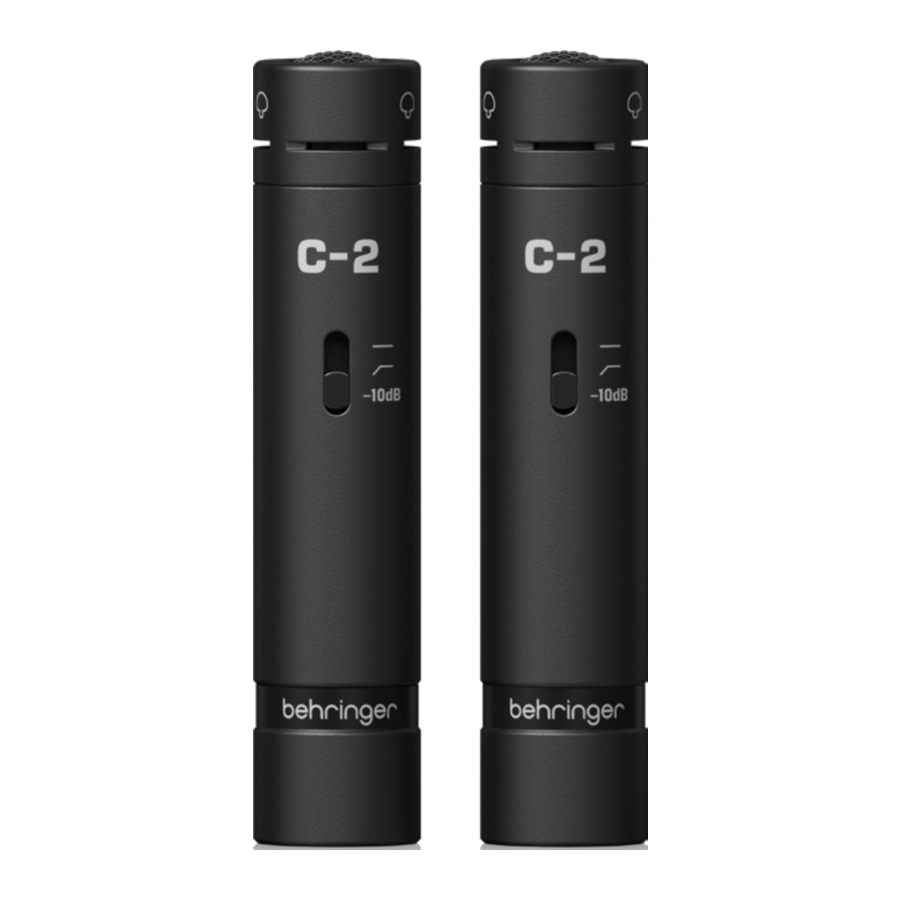
Behringer C-2, C-2 DARK EDITION Manual
- User manual (9 pages) ,
- User manual (6 pages) ,
- User manual (5 pages)
Advertisement

Introduction
By purchasing the Behringer C-2, you have obtained 2 condenser microphones that offer the highest quality standards and the best audio characteristics.
Both microphones have been matched to one another (matched pair), and are therefore particularly well-suited for stereo recordings. Of course, you can also use the microphones individually.
Their outstanding characteristics make these microphones a valuable tool in the studio and on the stage.
Power Supply
Phantom power (+48 V) is required to operate your microphone. We assume no liability for damage caused to your C-2 through deffective phantom power. Before activating phantom power, mute your playback system and connect the C-2 to the microphone input of your mixing console. After activating phantom power, the C-2 requires several seconds to stabilize itself.
Pickup Patterns
Both microphones feature a capsule with a cardioid pickup pattern.
Microphones with this polar pattern are most sensitive to sound coming from in front of the microphone, and also to a lesser extent from the sides. Sound coming from behind the microphone will be greatly attenuated. This makes the caqrdioid polar pattern most suitable for recording individual instruments or vocals within a group.
The so-called proximity effect is typical for microphones with the cardioid pickup pattern. Depending on the distance between the microphone and the sound source, a slight increase in the lower frequency range occurs. The shorter the distance, the more pronounced this effect. By cleverly selecting the position and the angle of your microphone, you can effectively manipulate the proximity effect and thus affect how your recording sounds. Experiment with various positions in order to gain more experience.
Possible Applications
Both microphones have been matched to one another (matched pair). Therefore, they are particularly well-suited for stereo recordings. Regardless of whether you are miking an entire ensemble or a single sound source (e.g. drums, piano or background vocals), this pair of condenser microphones lets you achieve outstanding spatial impressions in every recording session.
Of course, you can use your microphones individually as well. A cardioid pattern capsule is often used in recording situations in which several sound sources are present. Since this capsule selectively tones down the pickup of sounds located to the side of the microphone, this way you can achieve good separation of sound sources, thus easily avoiding feedback.
Low Cut-Filter and Signal Level Attenuation (-10 dB)
The C-2 studio microphones feature a switchable low-cut filter that lets you eliminate low-frequency disturbances such as subsonic noise. Set the switch to its middle position to activate the low-cut filter.
A switchable level attenuation is provided on your C-2s for applications in which the microphones are exposed to extremely high sound pressures. When the switch is in its "−10 dB" position, the level attenuation is activated. When the switch is in its top-most position, the signal is not influenced in any way.
Microphone Installation
To attach the microphones to the microphone stands, two clamps are included with the delivery. First screw a clamp onto the stand before attacting the microphone itself.
Audio Connection
Use a balanced XLR microphone cable with the following pin assignment: pin 1 = shielding; pin 2 = +; pin 3 = -. Since your C-2 features gold-plated contact points throughout, we recommend that you use only microphone cables with goldplated connectors.
Level Setting/Adjusting the Basic Sound
Adjust the gain control in the microphone channel of your mixing console so that the peak LED lights up only occasionally or never at all. The EQ controls in the microphone channel should be set to mid-travel position to start with; low-cut filter and signal level attenunation should be switched off. To get the sound you want, try changing the mic position relative to the sound source or even move the microphone around in the recording room of your studio. Adjusting the angle at which walls face the sound source can also be helpful. Only when the desired basic sound has been achieved, should you start to use equalizers and signal processors, if any at all. Remember: less is often more!

Polar pattern

Frequency response
Safety Instruction
- Please read and follow all instructions.
- Keep the apparatus away from water, except for outdoor products.
- Clean only with a dry cloth.
- Do not block any ventilation openings. Install in accordance with the manufacturer's instructions.
- Do not install near any heat sources such as radiators, heat registers, stoves or other apparatus (including amplifiers) that produce heat.
- Use only attachments/accessories specified by the manufacturer.
- Use only specified carts, stands, tripods, brackets, or tables. Use caution to prevent tip-over when moving the cart/apparatus combination.
![]()
- Avoid installing in confined spaces like bookcases.
- Do not place naked flame sources, such as lighted candles.
- Operating temperature range 5° to 45°C (41° to 113°F).
Documents / ResourcesDownload manual
Here you can download full pdf version of manual, it may contain additional safety instructions, warranty information, FCC rules, etc.
Advertisement





















Need help?
Do you have a question about the C-2 and is the answer not in the manual?
Questions and answers